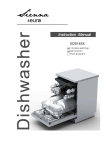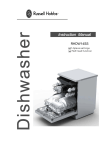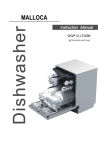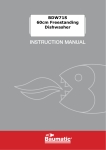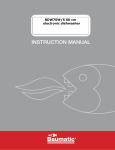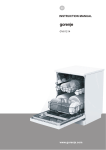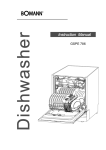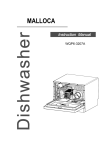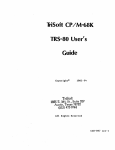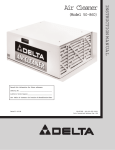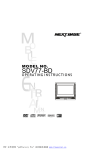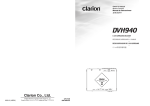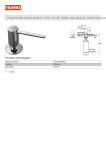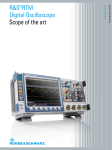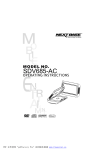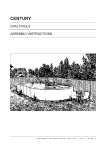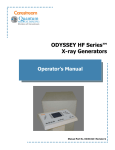Download EDS845SX
Transcript
euro EDS845SX 10 place settings For detailed operating method read the corresponding content on the instruction manual. Switch on the appliance Fill the detergent dispenser Check the rinse aid level Press the On/Off button to switch on the appliance, Open the door. Compartment A: With each wash cycle. Compartment B: For programmes with pre-wash only. (Follow the User Manual!) C A Mechanical indicator C. Electric indicator on control panel (if provided). Load the baskets Scrape off any large amount of leftover food. Soften remnants of burnt food in pans, then load the baskets. Refer to the dishwasher loading instructions. Select a programme Close the door,press the Programme Button until the selected programme lights up. ( See the section entitled“Operation instruction”) Running the dishwasher Changing the programme B T urn on the water tap and press the Start/Pause Button. The machine will start working after about 10 seconds. 1. A running cycle can only be modified if it has been running for a short time. Otherwise the detergent may have already been released and the water already drained. If this is the case, the detergent dispenser must be refilled. 2. Press the Start/Pause button, press the program button for more than three seconds,the machine will be in standby state, then you can change the program to the desired cycle setting Add forgotten dishes in the dishwasher. 1.Press the Start/Pause Button to stop the washing. 2.Open the door a little . 3.After the spray arms stop working, you can open the door completely. 4.Add forgotten dishes. 5.Close the door. 6.Press the Start/Pause Button, the dishwasher will run after 10 seconds. If the appliance is switched off during a wash cycle. If the appliance is switched off during a wash cycle, when switched on again, please re-select the washing cycle and operate the dishwasher according to the original Power-on state. Switch off the appliance Turn off the water tap, unload the baskets Open the doo r carefully. Hot steam may esc ape when the door is opened! When the working cycle has finished, the buzzer of the dishwasher will sound 8 times, then stop. Turn off the appliance using the On/Off Button. Warning: wait a few minutes (about 15 minutes) before unloading the dishwasher to avoid handling the dishes and utensils while they are still hot and more susceptible to break. They will also dry better.Unload the appliance, starting from the lower basket. Dear Customer, This appliance is in tended to be used in household and similar applications such as: -staff kitch en areas in shop s, offices and other working environme nts; -farm hous es; -by clients in hotels, motels and othe r residential type environments; -bed and breakfast type environments. Please carefully read this manual before using the dishwasher, it will help you to use and maintain the dishwasher properly. Keep it as a refer in the later days. Pass it on to any subsequent owner of the appliance. This manual contains sections on safety Instructions, Operating Instructions, Installat ion I nstructions and Tr oubleshooting Tips, etc. Control Panel...................................................2 Dishwash er Features.................................... ...2 A、F ill the Rinse Aid Dispenser............. ..... .. ... ..3 B、Function of Detergent ........ .........................4 Attention b efore o r after loading the Dish washer Ba skets..........................................................6 The Method of Loading Normal Dishware ..... ...... 7 Wash Cycle Table...........................................8 Turning on the Appliance................................9 Change the Programme.............. .... ................9 At the end of the Wash Cy cle...........................9 Filtering System.............................................10 Caring for the Dishwasher..................... . .........11 To review the section on troubleshooting Tips will help you to solve some common problems by yourself . If you can not solv e the problems by yourself , please ask for the help of professional technicians. Po sitioning the Appliance................... .. ..........12 Ab out Power Connection........................ . .......12 Water Co nnection.................................. . .......13 Start of dishwasher................................ .. ......14 Be fore calling for service........................... . .....15 Error codes.................................... . ..............16 Tech nical info rmation.............................. .......17 The manufacturer, following a policy of constant development a nd u pdating of the product, may make modifications without giving prior notice. When using your dishwasher, follow the precautions listed below: This appliance must be grounded. In the event of a malfunction or breakdown, grounding will reduce the risk of an electric shock by providing a path of least resistance of electric current. This appliance is equipped with a cord having an equipmentgrounding conductor and a grounding plug. The plug must be plugged into an appropriate outlet that is installed and grounded in accordance with all local codes and ordinances. Do not abuse, sit on, or stand on the door or dish rack of the dishwasher. Do not touch the heating element during or immediately after use. (This instruction is only applicable to machines with a visual heating element.) Do not operate your dishwasher unless all enclosure panels are properly in place. Open the door very carefully if the dishwasher is operating, there is a risk of water squirting out. Do not place any heavy objects on or stand on the door when it is open. The appliance could tip forward. When loading items to be washed : 1) Locate sharp items so that they are not likely to damage the door seal; 2 ) Warning: Knives and other utensils with sharp points must be loade d in the basket with their points down or placed in a horizontal position. When using your dishwasher, you should preve nt plastic items from coming into contact with the heating element.(This instruction is only applicable to machines with a visual heatin g element.) Check th at the detergent comparment is e mpty after completion of th e wash cycle. Do not wash plastic items unless they are marked dishwasher safe or the equivalent. For plastic items not so marked, check the manufacturer's recommendations. Use only deterge nt and rinse additives designed for an automatic dishwasher. Never use soap, laun dry dete rgent, or hand washing detergent in you r dishwa sher. Keep these products out of the reach of children. Improper connection of the equipment-grounding conductor can result in the risk of an electric shock. Check with a qualified electrician or service representative if you are in doubt whether the appliance is properly grounded. Do not modify the plug provided with the appliance; If it does not fit the outlet. Have a proper outlet installed by a qualified electrician. Keep children away from detergent and rinse aid, keep children away from the open door of the dishwasher, there could still be some detergent left inside. This appliance is not intended for use by persons (including children )with reduced physical, sensory or mental capabilities, or lack of experience and knowledge ,unless they have been given supervision or instruction concerning use of the appliance by a person responsible for their safety. Children should be supervised to ensure that they do not play with the appliance. The dishwasher must always be connected to the water system using new hose sets. Dishwash er detergents are strongly alkaline, they can be extremely dangerous if swallowed. Avoid contact with skin and eyes and keep children away from the dishwasher when the door is open. The door should not be left open, since this could increase the risk of tripping. If the s upply cord is damaged, it must be replaced by the man ufacturer or its serv ice agent or a similarly qualified person in order to avoid a hazard. If the appliance is installed on a carpet floor, take care that the openings in its base are not obstructed. Remove the door to the washing compartment when removing an old dishwasher from service or discarding it. Plea se d ispo se of packing materials properly. Use the dishwasher only for its intended function. During installation, the power supply must not be excessively or dangero usly bent or flattened. Do not tamper with controls. The a ppliance is to be connected to the water mains using new hose sets and that old hose-sets should no t be reused. The maximum number of place setting s to be washed is 10. The maximum permissible inle t wa ter pressure is 1Mpa . The minimum permissible inlet water press ure is 0.04Mpa. To get the best performance from your dishwasher, read all operating instructions before using it for the first time. 1. On/Off Button: to switch On/Off the applian ce. 2.De lay Button : Press the button to add th e delay time. 3.Half load and Extra dry functions Button: To select Half-load function or Extra Dry function. 8.Extra Drying indicator: Ex tra drying: An increased temperature during the fin al rinse to increase drying well. There is a slight increase in the energy consumption. 9.Program indic ators: To show which progra m you have chose. 4.Program Button : To Pre ss the button to select appropriate Prog ram. 10.Other indicators: 5.Start /Pause button: To start the selected washing program or pause the washing program when the machine is working. 6.Display screen: to sho w the remaining time and the state (running state, delay time, erro r code s etc ) 7.Ha ft load indicator : To show when you select the haft load function. If you have only about or less than half of full load dishes of the dishwasher, you can select the half load function and you r desired program acco rdin g to the dishes conta minated degree (The rapid prog rams can’t sele ct th is function). A program select the half load function, it can save time , energy, and water compare to the program hasn’t select the half load function. After the half load fu nction is selected, all the spray arms a re running, you can load all the baskets. Rinse Aid indicator: Indicates when the dispenser needs to be refilled. Wate r faucet indicator: To show when the water faucet is forgot to open. Child loc k indicator: Attention: Child lock function: pres s Delay button and Half load/Exra dry button simultan eous ly to lock the program, the same way to unlock th e operation. Ba ck View Front view 1 2 3 7 4 5 8 9 6 10 1 2 3 Top spray arm Cutlery rack Upper basket 4 5 6 Inner pipe Lower basket Dispe nser 7 8 9 11 Cup shelf Spray arms Filter assembly 10 11 Inle t pipe conne ctor Drain pipe Before using your dishwas her for the first time: A. Fill th e rinse a id dispenser B. Fill in detergent Rinse Aid Dispenser The rinse aid is released during the final rinse to prevent water from forming droplets on your dishes, which can leave spots and streaks. It also improves drying by allowing water to roll off the dishes. Your dishwasher is designed to use liquid rinse aids. The rinse aid dispenser is located inside the door next to the detergent dispenser. To fill the dispenser, open the cap and pour the rinse aid into the dispenser until the level indicator turns completely black . The volume of the rinse aid container is about 110ml. Function of Rinse Aid Rinse aid is automatically added during the last rinse, ensuring thorough rinsing, and spot and streak free drying. Attention! Only use branded rinse aid for dishwasher. Never fill the rinse aid dispenser with any other substances (e.g. Dishwasher cleaning agent, liquid detergent). This would damage the appliance. When to Refill the Rinse Aid Dispenser If there is no rinse-aid warning lig ht in the control p anel, you can judge the amount of rinse-aid by the color of the optical level indicator "C" located next to the cap. When the rinse-aid container is full, the whole indicator will be dark .As the rinse-aid diminishes, the size of the dark dot decreases. You should never let the rinse aid get below 1 / 4 full. As the rinse aid diminishes, the size of the black dot on the rinse aid lev el indicator changes, as illustrated be low. Fu ll 3 / 4 fu ll 1 / 2 fu ll 1 / 4 fu ll - Should refill to eliminate spotting Empty RINSE AID DISPENSER 1 2 3 To open the dispenser, turn the cap to the "open" (left) arrow and lift it out. Pour the rinse aid into the dispenser, being careful not to overfill. Replace the cap by inserting it aligned with "open" arrow and turning it to the closed (right) arrow. Be careful not to overfill the dispenser, because this could cause over sudsing. Wipe away any spills with a damp cloth. Don't forget to replace the cap before you close the dishwasher door. Attention! Clean up any rinse aid spilt during filling with an absorbent cloth to avoid excess foaming during the next wash. Adjusting Rinse Aid Dispenser The rinse aid dispenser has six or four settings. Always start with the dispenser set on "4". If spots and poor drying are a pro ble m, increase the amount of rinse aid dispensed by removing the dispe nser lid and rotating the dial to "5". If the dishes are still not drying properly or are showing spots, adjust the dial to the next higher lever until your dishes are spot-free. The recommended setting is "4". (Factory value is "4".) Increase the dose if there are drops of water or lime spots on the dishes after washing. Reduce it if there are sticky whitish stains on your dishes or a bluish film on glassware or knife blades. Detergents with its chemical ingredients are necessary to remove dirt, crush dirt and transport it out of the dishwasher. Most of the commercial quality detergents are suitable for this purpose. Detergents There are 3 sorts of detergents 1.With phosphate and with chlorine 2.With phos phate and without chlorine 3.Without phosphate and without chlorine Normally new pulveris ed d etergent is without p hosphate. Thus the water softene r function of phosphate is not given. In this case we recommend to fill salt in the salt container even when the hardness of water is only 6 °dH. If detergents without phosphate are used in the case of hard water often white sp ots appear o n dishes and gla sses. In this case please add more detergent to reach better results. Detergents with out chlorine do only bleach a little. Strong and coloured sp ots will not be removed completely. In this case please choose a progra m with a higher temp erature. Concentrated Detergent Ba sed on their chemical composition, detergents can be split in two basic types: conventional, alkaline detergents with caustic components low alkaline concentrated detergents with natural enzymes Th e use of“no rmal ” washing programs in combination with concentrated detergents reduces pollution a nd is good for your dishes ; these wash programs are specifically matched to the dirt-diss olving prope rties of the enzymes of the concentrated detergent. For this reason “normal”wash programs in which concentrated detergents are used can achieve the same results that can oth erwise only be achieved using “intensive ” programs. Detergent Tablets Deterg ent tablets of different brands dissolve at different speeds. For this reason some detergent tablets cannot dissolve an d develop their full cleaning power during short progra ms. Therefore please use long programs when using d etergent tablets, to ensure the complete removal of detergent residuals. Detergent Dispenser Th e dispenser mus t be refilled before the start of each wash cycle following the instructions provided in the wash cycle table . Your dishwasher uses less detergent and rinse aid than Conventional dishwasher. Generally, only one tablespoon of detergent is needed for a normal wash load. More h eavily soiled items need more deterge nt. Always add the detergent just before starting the dishwasher, otherwise it could g et damp and will not dissolve properly. Amount of Detergent to Use If th e lid is close d: press rele ase button. The lid will spring ope n. Always add the dete rgent just before starting each wash cycle. Only use branded detergent and rinse aid for dishwasher. Dishwasher detergent is corrosive! Take care to keep it ou t of reach of c hildren. Proper Use of De terg ent Use only deterge nt specifically made for the use in dishwashers. Keep your detergent fresh and dry. Don't put powdered d etergent into the dispenser until you're ready to wash dishes. Fill in Detergent A B Fill the detergent dispen ser with detergent. The marking ind icates the dosing levels , as illustrated o n the right: A The place for main wash cycle detergent. B The place for pre -wash cycle detergent. Please observe the man ufacturers dosing an d storag e Recommendations as stated on the detergent packaging. Close the lid and press until it locks in place. If the dishes are heavily soiled, place an additional deterge nt dose in the pre-wash detergen t ch amber. This detergent will take effect during the pre-wash phase. The information about the amount of detergent for the single programme please refer to the Wash Cycle Table on the page 8. Plea se b e aware, that according to the level soiling and the specific hardness of water d ifferences are possible. Plea se o bserve the manufacturer's recommendations on the detergent packaging. Consider buying utensils which are identified as dishwasher-proof. Use a mild detergent that is described as 'kind to dishes'. If necessary, seek further information from the detergent manufacturers. For particular items, select a program with as low a temperature as possible. To prevent damage, do not take gla ss a nd c utlery out of the dishwasher immediately after the programme h as ended. Are not suitable Are of limited suitability Cutlery with wooden, horn china or mother-of-pearl handles Plastic items that are not heat resistant Older cutlery with glued parts that are not temperature resistant Bonded cutlery items or dishes Pewter or cooper items Crystal glass Steel items subject to rusting Wooden platters Items made from synthetic fibres Some types of glasses can become dull after a large number of washes Silver and aluminum parts have a tendency to discolour during washing Glazed patterns may fade if machine washed frequently (For best performance of the dishwasher, follow these loading guide lines. Features and appearance of baskets and cutlery baskets may vary from your model.) Scrape off any large amounts o f leftover food. Soften remnants of burnt food in pans. It is not necess ary to rinse the d ishes under running water. Place objects in the dishwasher in the following way: 1.Items such as cups, glasses, pots /pans, etc. are faced downwards. 2.Curved items, or ones with recesses, should be loaded aslant so that water can run off. 3.All utensils are stacked securely and can not tip over. 4.All utensils are placed in the way that the spray arms can rotate freely during washing. Very small items should not be washed in the dishwasher as they could easily fall out of the basket. Load hollow items suc h as cup s, glasses, pans etc. With the opening facing downwards so that water can not collect in the con tainer or a deep b ase. Dishes and items of cutlery must not lie ins ide one another, or cover each oth er. To avoid damage to glasse s, th ey must not touc h. Load large ite ms which are most difficult to clea n into the lower bask et. The upper basket is designed to ho ld more delicate and lighter dishware such as glasses , coffee and tea cups Long bladed knives stored in an upright position are a potential haza rd! Long and/or sharp items o f cutlery such as carving kniv es must be positioned horizonta lly in the upper b asket. Please do not ove rload yo ur dishwasher. This is important for good results and for reasonab le consumption of energy. To prevent water dripping from the uppe r basket into the lower basket, we recommend that you empty the lower basket first and then the upper basket. The u pper basket is designed to hold more delicate and lighter dishware such as glasses, coffee and tea cups and saucers, as well as plates, small bowls and shallow pans (as long as they are not too dirty). Position the dishe s an d co okware so that they will not get moved by the spray of wate r. We suggest that you place large items and the most difficult to clea n ite ms are to be placed into the lo wer basket: such as pots, pans, lids, se rving dishes and bowls, as shown in the figure below. It is pre ferable to place serving dishes and lids on the side of the rack s in order to avoid blocking the ro tation of the top spray arm. Please be reminded that: Pots, serving bowls, etc, must always be placed top down. Deep pots should be slan ted to allow water to flow out. The Botto m Basket features fo lding spikes so that larger or more pots and pans can be loaded. Adjusting the Upper Basket Folding back the cup shelives The height of the upper basket can be adjusted in order to create mo re space for large utensils both for the upper /lower basket. The height of the upper basket can b e adjusted by placing the wheels on different height of the rails. Long items, serving cutlery, salad servers and knives should be placed on the shelf so that they do not obstruct the ro tation of the spray arms.. Fo r better stacking of po ts and pans, the spikes c an b e folded down as sho w in the picture right. Folding Spikes of Lower Basket For better stacking of pots and pans, the spikes can be folded down as show in the picture right. Cutlery should be pla ced in the cutlery rack separately from each other in th e ap propriate positions, and d o make sure th e utensils do not nest together, this may cause bad performance. ( ) Means: need to fill rinse into the Rinse-Aid Dispenser. For heaviest soiled crockery, Intensive and normally soiled pots、 pans、dishes etc with dried on soiling. Heavy Normal (* AS/ NZS 2 00 7.1) Glass 90 Min Rapid Soak For hea vily so iled loads, such as pots, plates, gla sses and lightly soiled pans. Standard daily cycle for normally soiled loads, such as pots、plates、glasses. For lightly soiled loads, such as glasses, crystal and fine china. For normally soiled loads that need quick wash. A shorter wash for lightly soiled loads that do not need drying. To rinse dishes that you plan to wash late r that day . Pre-wash(50 ℃) wash ( 65 ℃) Rinse Rinse Rinse(65℃) Drying Pre-wash(45 ℃) Wash (55 ℃) Rinse Rinse (65 ℃) Drying Pre-wash Wash (50 ℃) Rinse Rinse(50℃) Drying Pre-wash wash(40℃) Rinse Rinse(60℃) Drying 5/22.5g 135 1.2 16 155 1.05 13 130 0.61 12.2 110 0.7 13 (Or All in1 ) 5/22.5g (Or All in1 ) 5/22.5g (Or All in1 ) 5/22.5g (Or All in1 ) Wash(65℃) Rinse(60℃) Rinse (65℃) Drying 27.5g 90 1.1 10.5 Wash (40 ℃) Rinse Rinse (45 ℃) 20g 40 0.45 10 Pre-wash 8 0.01 * AS/NZS 2007.1 : This program is the test cycle. The information for comparability test in accord ance with AS/NZS 2007.1 , as follows: Capacity: 10 setting Po sition Upper ba sket: upper wheels o n rails Rinse aid setting: 6 Open the d oor slightly 50mm to assist in drying of the dishes after every wash 3.5 Starting a cycle wash 1 2 3 4 5 Draw out the lower and upper basket, load the dishes and push them back. It is recommended to load the lower basket first, then the upper one (see the section entitled “Loading the Dishwasher”). Pour in the detergent (see the section entitled“ Detergent and Rinse Aid”). Insert the plug into the socket. The power su pply is 220-240 VAC /50 HZ, the specification of the socket is 10A 25 0VAC. Make sure that the water supply is turned on to full pressure. Close the door, press the ON/OFF Button, and the display will turn on. Press the program Button to select your desired program. If a program is selected, the response light will light. Then press the Start/Pause button, th e dishwasher begins to start. When you press th e Start/Pause button to pause during washing, the running indicator will stop blinking and the dishwasher will be beeping every minute unless you press the Start/Pause button to start. Premise: A cycle that is underway can on ly be modified if it has only been running for a short time. Otherwise, the detergent may have already be en released, a nd the appliance may have already drained the wash water. If this is the case , the detergent dispenser mu st be refilled (see the section entitled " Loading the Detergent " ). 2 Press the Start/Pause button, the machine will pause, press the program button for more tha n 3 seconds, then you can change the program to the desired cycle setting (see the section entitled " Starting a wash cycle. . ." ). 1 If you ope n the door during a wash cycle , the mach ine will paus e. The program light will stop blinking and the buzzer will be beeping every minu te un less you close th e door . After you close the door ,the ma chine will keep o n working after 10 seconds. A forgotten dish can be added any time before the detergent cup opens. Add forgotten dishes. 1 Press the Start/Pause button 4 2 Open the door a little to stop the washing. the spray arms stop working,you can open the door 3 After completely. 5 6 Close the door Press the Start/Pause button, the dishwasher will run after 10 seconds. When the wo rking cycle has finished, the buzzer of the dishwasher will sound for 8 seconds, then stop. Turn off the appliance using the Powe r switch button, shut off the water supply and open the doo r of the dishwasher. Wait for a few minutes before unlo ading th e dishwasher to avoid ha ndlin g the dishes and utensils while they are still hot and more susceptible to break age. The y will also dry better. Switch Off the Dishwasher The program light is on but is not blinking, only in this case the programme has ended. 1.Switch off the dishwasher by pressing the Power button. 2.Turn off the water tap. Open the door carefully. Hot dishes are sensitive to knocks. The dishes should therefore be allowed to cool down around 15 minutes before removing from the appliance. Open the dishwasher door, leave it ajar and wait a few minutes before removing the dishes. In this way they will be cooler and the drying will be improved. Unloading the dishwasher It is normal that the dishwasher is wet inside. Empty the lower basket first and then the upper one. This will avoid water dripping from the upper Basket onto the dishes in the lower one. It is dangerous to open the door when washing, because the hot water may scald you. The filter prevents larger remnants of food or other objects from getting inside the pump. The residues may block the filter, in this case they must be removed. The filter system consists of a coarse filter,a flat (Main filter) And a microfilter(Fine filter). Main filter 2 1 Fo od and soil particles trap ped in this filter are pulverized by a specia l jet on the lower spray arm and washed down to drain. 1 Coarse filter 2 La rger ite ms, such as p ieces of bones or glass, that could block the drain and easily become tra pped in the course filter To remove the items caught b y the filter, ge ntly squeeze the tap on the top of this filter and lift out. 3 Fine filter 3 This filter holds soil and food residues in the sump area a nd preve nts it from being redeposited on the dishes during wash cycle. Filter assembly The filter efficiently re mo ves food particle s from the wash water, allowing it to be rec ycled during the cycle. For best performance and results, the filter must be cleaned re gularly. For this reason, it is a goo d idea to remove the larger food particles trapp ed in the filter after e ach was h cycle by rinsing the semicircular filter and cup under runnin g water. To remove the filter device, pull the cup handle in the upward d irection. The d ishwasher must never b e used without the filters. Improper replacement of the filter may reduce the performance level of the appliance and damage dishes and utensils. 1 Step 1: Turn the filter in anti-clockwise direction. 2 Step 2:lift the filter up. When following this procedure from step 1 to step 2, the filter system will be removed; when following it from Step 2 to Step 1, the filter system will be installed. Remarks: - Inspect the filters for blo cking a fter e very time the dishwa sher has been used. - By unscrewing the coarse filter, you can remove the filter system. Re move any foo d remna nts and clean the filters under running water. The entire filter assembly should be cleaned once a week. Cleaning the Filter To clean the coarse filter and the fine filter, use a c leaning b rush. Reassemb le the filter p arts as shown in the figures on the previo us page and reinsert the entire assembly in the dis hwa sher, positio ning it in its seat and pressing downwards. When cleaning the filters, don't knock on them. Otherwise, the filters could be contorted and the performance of the dishwasher could be decreased. The control panel can be cleaned by using a lightly dampened cloth. After cleaning, make sure to dry it thoroughly. For the exterior, use a good appliance polish wax. Never use sharp objects, scouring pads or harsh cleaners on any part of the dishwasher. Cleaning The Door To clean the e dge around the door, you should use only a soft warm, damp cloth. To avoid pene tration o f wa ter into the door lock and electrical components, do not use a spray cleaner of any kind. Never use a spray cleaner to clean the door panel as it may damage the door loc k and electrical components. Abrasive agents or some paper towels shou ld not be used becau se of the risk of scratching or leaving spots on the stainless steel surface. Protect Against Freezing please take frost protection measures on the dishwasher in winter. Every time a fter washing cycles, please operate as follows: 1.Cut off the electrical power to the dishwasher. 2.Turn off the water supply and disconnect the water inlet pipe from the water valve. 3.Drain the water from the inlet pipe an d water valve. (Use a pan to gather th e water) 4.Reconnect the water inlet pipe to the water valve. 5.Remove the filter at the bottom of the tub and use a sponge to soak up water in the sump. If your dishwasher cannot work because of the ice, please contact professional service persons. Cleaning the Spray Arms It is necessary to clean the spra y arms re gularly fo r hard wate r che micals will clog the sp ray arm jets a nd bearings. To remove the up per spray arm, hold the nut, rotate the arm clockwise to remove it. To remove th e lower spray arm, pull out the spray arm u pwa rd. Wash the arms in soapy and warm water and use a soft brush to clean the jets. Replace them after rinsing them thoroughly. After Every Wash When not in Use for a Long Time After every wash, turn off the water supply to the appliance and leave the door slightly open so that moisture and odours are not trapped inside. It is recommend that you run a was h cy cle with the dishwasher empty an d the n remove the plug from the socket, turn off the wa ter supply and leave the door of the appliance slightly open. This will help the d oor seals to last longer and prevent odours from forming within the appliance. Remove the Plug Before cleaning or performing maintenance, always remove the plug from the socket. No Solvents or Abrasive Cleaning To cle an the e xterior a nd rubber p arts of the dishwasher, do not use solvents or abrasive cle aning products. Only use a clo th with warm so apy water. To remove spots o r stains from the surface of the interior, use a cloth da mpened with water a nd a little vinegar, o r a cleaning pro duct mad e specifically for dishwashers. Moving the Appliance If the appliance must be moved, try to keep it in the vertical position. If absolutely necessary, it can be positioned on its back. Seals One of the factors that cause odours to form in the dishwasher is food that remains trapped in the seals. Periodic cleaning with a damp sponge will prevent this from occurring. Position the appliance in the desired location. The back should rest against the wall behind it, and the sides, along the adjacent cabinets or walls. T he dishwasher is equipped with water supply and drain hoses th at can be positioned either to the righ t or the left sides to facilitate proper installation. Once the appliance is positioned for levelling, the height of the dishwashe r may be altered via adjustment of the screwing level of the feet. In any case, the applia nce should not be inclined more than 2 . For personal safety: DO NOT USE AN EXTENSION CORD OR AN ADAPTER PLUG WITH THIS APPLIANCE. DO NOT, UNDER ANY CIRCUMSTANCES, CUT OR REMOVE THE EARTHING CONNECTION FROM THE POWER CORD. Plea se look at the rating label to know the rating voltage and connect the dishwasher to the appropriate power supply. Use the required fuse 10 amp , time delay fuse or c ircuit breaker recommended and provide separate circuit serving only this appliance. Ensure the voltage and frequency of the power being used corresponds to those on the rating plate. Only in sert the plug into an electrica l socke t which is earthed prop erly. If the electrical socket to which the appliance must be connected is not appropriate for the plug , replace the socket, rather than using a a daptor or the likes as they could cause ove rheating an d burns. This appliance must be earthed. In the event of a malfunction or breakdown, earthing will reduce the risk of electric shock by providing a path of least resistance for the electric current. This appliance is equipped with a cord having an equipment-earthing conductor and an earthing plug. The plug must be plugged into an appropriate outlet that is installed and earthed in accordance with all local standards and requirements. Improper connection of the equipment earthing conductor can result in the risk of an for personal safety: electric shock. DO NOT USE AN EXTENSION CORD OR AN ADAPTER PLUG WITH THIS APPLIANCE. Check with qualified electrician or service representative if you areTHE in doubt whether the DO a NOT, UNDER ANY CIRCUMSTANCES, CUT OR REMOVE EARTHING appliance is properly earthed. CONNECTION FROM THE POWER CORD. Do not modify the plug provided with the appliance. If the plug does not fit properly to the outlet, please have a qualified electrician to install a proper outlet. Connect the cold water supply hose to a thread ed 3/4(inch) connector an d make sure that it is fastened tightly in place. If the water pipe s are new or have not been used for an extended period of time, let the water run to make sure th at the water is clear. This precaution is needed to avoid the risk of the water inlet to be blocked an d damage the applian ce. Please close the hydrant after using. Insert the drain hose into a drain pipe with a minimum diameter of 40mm, or let it run into the sink, making sure to avoid bending or crimping it. The top of the hose mus t be less than 1000mm. Front NOTE The top of the hose must be less than 1000mm. Drain pipe Counter A B φ 40 mm How to Drain Excess Water From Hoses If the sink is 1000mm higher from the floor, the excess water in hoses cannot be dra ined directly into the sink. It will be necessary to drain excess water from hoses into a bo wl o r suitable container that is held outside and lower th an the sink. Water Outlet Connect the water drain hose. The drain hose mu st be correctly fitted to avoid water leaks. Ensure that the water dra in hose is no t kin ked or squashed. Extension Hose If you need a drain hose extension, make sure to use a similar drain hose. It must be no longer than 4 metres; otherwise the cleaning effect of the dishwasher could be reduced . Syphon Connection Insert the drain hose into a drain pipe with a minimum diameter of 40mm, or let it run into the sink, making sure to avoid bending or crimping it. The top of the hose must be less than 1000mm. The following things should be checked before starting the dishwasher. 1 The dishwasher is level and fixed properly 2 3 4 5 6 7 The inlet valve is open There is a leakage at the connections of the conducts The wires are tightly connected The power is switched on The inlet and drain hoses are knotted All packing materials and printings should be taken out from the dishwasher After installation, please make sure to keep this manual. The content of this manual is very helpful to the users. Fuse blown, or the home Replace fuse or reset circuit breaker. Remove any other circuit breaker has been appliances sharing the same circuit with the dishwasher triggered. Make sure the dishwasher is turned on and the door is Power supply is not closed securely. turned on Make sure the power cord is properly plugged into the wall socket. Error code:E1; Water pressure is low Check that the water supply is connected properly and the water is turned on. Door of dishwasher not properly closed. Make sure to close the door properly and latch it. Kink in drain hose Check drain hose. Filter clogged Check the filter (see section titled " Cleaning The Filter ") Kitchen sink clogged Check the kitchen sink to make sure it is draining well. If the problem is the kitchen sink not draining ,you may need a plumber rather than a serviceman for dishwashers. Improper detergent Use only the special dishwasher detergent to avoid suds. If this occurs, open the dishwasher and let suds evaporate. Add 1 gallon of cold water to the tub. Close and latch the dishwasher, then select any cycle. Dishwasher will drain out the water at the first step.Open the door after the draining has stopped and check if the suds have disappeared. Repeat if necessary. Spilled rinse-aid Always wipe up rinse-aid spills immediately. Detergent with colourant was used Make sure that the detergent is the one without colourant. Hard water minerals To clean the interior, use a damp sponge with dishwasher detergent and wear rubber gloves. Never use any other cleaner than dishwasher detergent for the risk of foaming or suds. The affected items are not corrosion resistant. The items should be corrosion resistant. A spray arm is knocking against an item in a basket Interrupt the programme, and rearrange the items which are obstructing the spray arm. Items of crockery are loose in the wash cabinet Interrupt the programme, and rearrange the items of crockery. This may be caused by on-site installation or the cross-section of the piping. This has no influence on the dishwasher function. if in doubt, contact a suitably qualified plumber. The dishes were not loaded correctly. See notes in " Loading the Dishwasher Baskets ". The programme was not powerful enough. Select a more intensive programme. See" Wash Cycle Table ". Not enough detergent was dispensed. Use more detergent, or change your detergent. Items are blocking the path of spray arms. Rearrange the items so that the spray can rotate freely. The filter combination in the base of wash cabinet is not clean or is not correctly fitted. This may cause the spray arm jets to get blocked. Clean and/or fit the filter combination correctly. Clean the spray arm jets. See "Cleaning the Spray Arms". Combination of soft water and too much detergent. Use less detergent if you have soft water and select a shorter cycle to wash the glassware and to get them clean. Aluminum utensils have rubbed against dishes. Use a mild abrasive cleaner to eliminate those marks. Dishes block detergent cups. Re-loading the dishes properly. Improper loading Load the dishwasher as suggested in the directions. Too little rinse-aid Increase the amount of rinse-aid/refill the rinse-aid dispenser. Dishes are removed too soon Do not empty your dishwasher immediately after washing. Open the door slightly so that the steam can escape. Begin unloading the dishwasher only once the dishes are barely warm to the touch. Empty the low basket first. This prevents water form dropping off dishes in the upper basket. Wrong program has been selected In short program the washing temperature is lower. This also lowers cleaning performance. Choose a program with a long washing time. Use of cutlery with a low-quality coating Water drainage is more difficult with these items. Cutlery or dishes of this type are not suitable for washing in the dishwasher. When some malfunctions come on, the appliance will display error codes to warn you: E1 Longer inlet time. Faucets is not opened, or water intake is restricted,or water pressure is too low. E4 Overflow. Some element of dishwasher leaks . If overflow occurs, turn off the main water supply before calling a service. If there is water in the base pan because of an overfill or small leak, the water should be removed before restarting the dishwasher. Height : Width : Depth : Water pressure: Power supply: Capacity: 845mm 448 mm 600mm (with the door closed) 0.04-1.0MPa see rating label 10 place settings





















